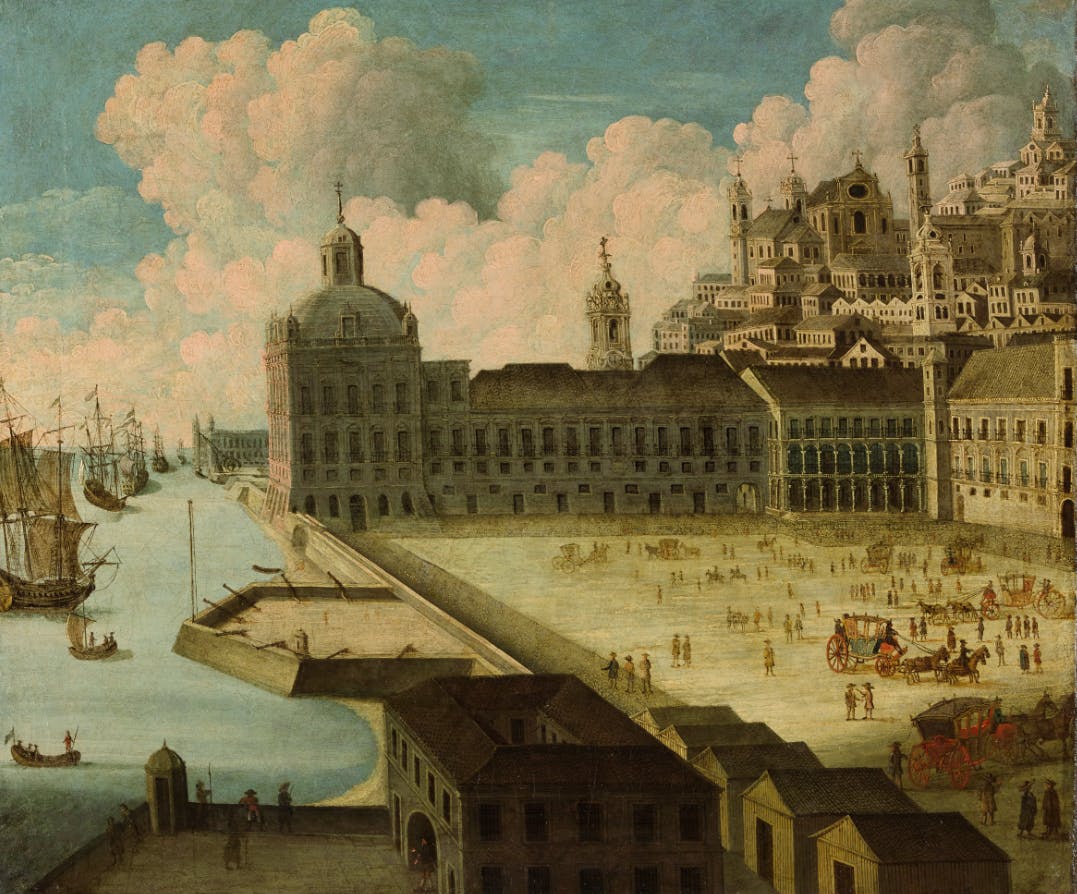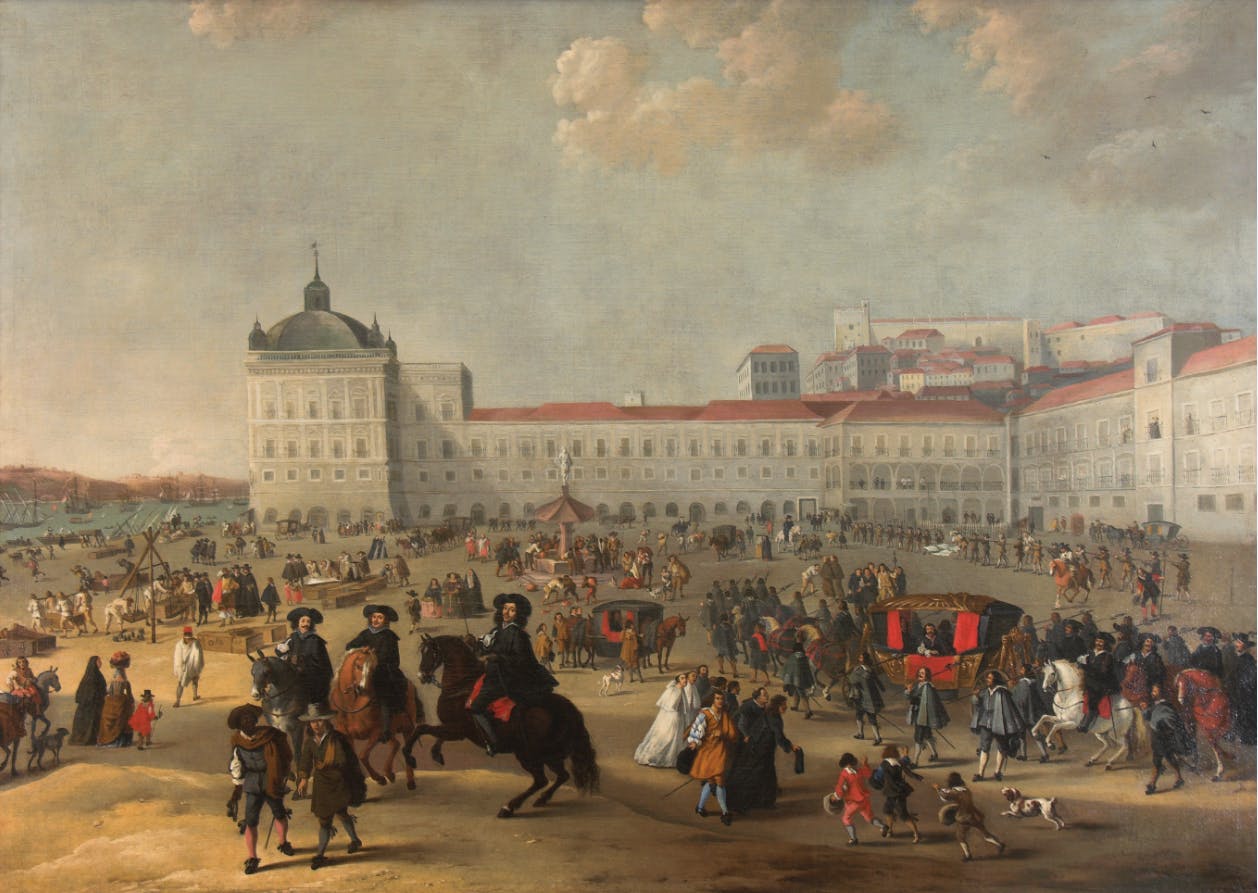At the time of the earthquake, Lisbon was Europe’s fourth-largest city—after London, Paris, and Naples—with about 200,000 inhabitants. On a normal day, most streets in the port town of Lisbon were populated with artisans, fishmongers, street vendors, dental surgeons, doctors, chocolate makers, hairdressers, and flower sellers. By the riverside, English, Flemish, and Spanish merchants mingled among groups of fishermen. Without a doubt, the riverside area teemed with construction workers, boat hands, caulkers, carpenters, barrelmakers, ropemakers, and of course, the occasional guitar-playing sailor. Between the Ribeira and the Terreiro do Paço, crowds of women dominated the street shops, with sardinheiras, fruit and vegetable sellers, bakers, and many water-walkers and washerwomen. There were also public notaries, clerks, insurers, goods registrars, officials from the Mint and the Customs House, writers, accountants, goldsmiths, watchmakers, and many merchants. Many monks from various religious orders mingled in the crowd. Travelers considered it filthy and stinky because the streets were filled with rubbish, wastewater, and stray dogs. People threw their rubbish and even wastewater out of their windows, warning those below by screaming, “Água Vai” meaning, “Here goes water”!
The many enslaved Africans were also a major presence in Lisbon's daily life. Every day, enslaved women carried dirty water and rubbish from houses out to the beaches in Alfama, Ribeira and Boa Vista, they were called “calhandreiras”. Others sold food on the street, alongside beggars. Other women sold charcoal or caught fish. Enslaved men carried goods or offered their services as whitewashers or watermen. But there were cases of enslaved men who saved money, bought their freedom, renting houses to guests, or opening shops in the street as artisans, potters, confectioners, or weavers. The most striking presence in the streets occurred during religious festivals, with the famous brotherhoods of men from Africa, often dressed according to their traditions. Groups of black musicians, often with wind instruments, also marked the celebrations and popular festivals. The presence of Portuguese people of African origin, organists in churches, or famous poets and viola players marked the history of the streets of Lisbon at the time of the Earthquake.
Amongst the crowd, Jews did not manifest their religious beliefs, due to fear of the Inquisition, but many would certainly walk the streets of Lisbon, whether as merchants, moneylenders, actors, simple craftsmen, or doctors. Some, converted to Christianity, called themselves New-Christians and tried not to arouse the suspicion of the Old-Christians. Others, more rare, continued to secretly maintain Jewish customs. Gypsies also circulated in the streets, with nomadic habits, but they were systematically deported to Brazil in the decades before the Earthquake. The men often traded horses and the women were associated with the magical arts, which was a source of great interest for the population, but also of mistrust and repression on the part of the authorities.
Another notable presence were the religious novices. There were so many religious novices that the monasteries and convents couldn’t afford to keep them. Women worked hard producing sweets and embroideries to sell, and many men were often forced to beg in the streets. In turn, the wealthier Lisboans avoided walking in the dirty streets and preferred riding in their coaches.
The day of the earthquake, things were different. It was All Saints Day, so the rich and poor, men and women, were together in the streets on their way to church, dressed in their best clothes. Many pilgrims, as well as sellers offering their products to passers-by, had come to Lisbon from the countryside.
Most rich families had a chapel in their homes for daily services, so visiting a public church for an important mass was an excellent, rare excuse to be outside and mingle, especially for women.


About 80 years apart, these two paintings show the same view of the city, the Terreiro do Paço, with the large square tower of the Ribeira Palace dominating the ensemble. We notice the care given to the architectural representation on the first painting, the characters being represented in a less detailed way. In the second painting, although it represents an older view of Lisbon, it is charming to linger on the details: nobles, merchants, enslaved people, children running, ladies strolling: people from all walks of life crossed paths in this square, from all walks of life.

Rossio Square, around 1750. The Hospital de Todos os Santos, with its Manueline portal, dominates the square, where aristocrats of both sexes stroll in unusual conviviality. The panel shows two carriages and the famous monumental fountain, built in the 16th century, crowned by a Neptune sculpted in stone. Also, note the small vendors – sometimes in rows of stalls, an unmistakable mark of daily life in Lisbon in the 18th century. The whole scene is framed by pelmets and brims that simulate brocades with their respective fringes and tassels.
Places to visit
- Museu de LisboaExplore
Continue Exploring
Bibliography
António BRÁSIO, Os Pretosem Portugal,Agência Geral dasColónias, 1944.
Carlos CAETANO, A Ribeira de LisboanaÉpoca da Expansão Portuguesa, Séculos XV a XVIII, Pandora, 2004.
Júlio de CASTILHO, A Ribeira de Lisboa, DescripçãoHistória da Margem do Teho, Desde a Madre-de-Deus até Santos-o-Velho, ImprensaNacional, Lisboa, 1893.
Suzanne CHANTAL, A vida quotidianaem Portugal ao tempo do terramoto, Livros do Brasil, 2005.
António Borges COELHO, Ruas e Gentes na Lisboa Quinhentista, Caminho, 2006
Júlio DANTAS, O Amor em Portugal no Século XVIII, LivrariaChardron, 1916.
José Pedro Sousa DIAS, Droguistas, Boticários e Segredistas. Ciência e Sociedade na Produção de Medicamentos na Lisboa de Setecentos, FundaçãoCalouste Gulbenkian/Fundação para a Ciência e Tecnologia, 2007.
Lidia FERNANDES, «Sinais de umquotidiano que o terramoto de 1755 interrompeu. Os vestígiosdetectados no Museu de Lisboa - TeatroRomano», Arqueologia e História, Revistaassociação dos ArqueólogosPortugueses. Vol. 68, 2016, pp. 89-102.
José-Augusto FRANÇA, Lisboa pombalina e o Iluminismo, Bertrand Editora, 1987.
J. A. Pinto FERREIRA, Os Mesteirais na AdministraçãoPúblicaem Portugal, EdiçõesMaranus, 1951.
Vitorino Magalhães GODINHO, Estrutura da AntigaSociedade Portuguesa, Edições 70, 2019.
Isabel Castro HENRIQUES, RoteiroHistórico de uma Lisboa Africana, séculos XV-XXI, Colibri, 2021.
António Manuel HESPANHA, As vésperas do Leviathan:instituições e poderpolítico: Portugal - séc. XVII, Almedina, 1994.
Franz-Paul LANGHANS, As corporacãcs dos oficiosmecânicos, 2 vols., ImprensaNacional, 1943-1946.
Francisco SANTANA, Bruxas e Curandeiros na Lisboa Joanina,Academia Portuguesa de História, 1996.
NunoLuís MADUREIRA, Lisboa 1740-1830, Cidade, espaço e quotidiano, LivrosHorizonte, 1992.
Arnaldo MELO, Amélia POLÓNIA e NunoLuís MADUREIRA, História do Trabalho e dasOcupações, 3 vols, CeltaEditora, 2001.
Jorge Borges de MACEDO, Problemas de História da Indústria Portuguesa no Século XVIII,EditorialQuerco, 1982.
Eduardo Freire de OLIVEIRA, Elementos para a História do Município de Lisboa, vol. XV, Topogafia Universal, 1906.
Maria da Graça SILVA, Leis e Saberes do Ofício de Alfaiate na ÉpocaModerna: O Caso da Cidade de Lisboa Setecentista, Dissertação de Mestrado, Universidade de Lisboa, 2012.